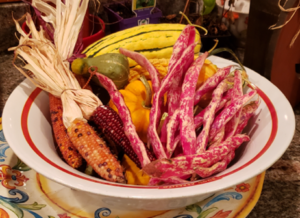Years ago, most of us with regular jobs went back to work on the day after Thanksgiving. But today, most people take the whole weekend to celebrate and relax. And this longer celebration certainly harkens back to earlier times…
In fact, the first American Thanksgiving, which most of us learned occurred in 1621 in Plymouth, Massachusetts, was a three-day-long gathering.
Of course, we now know that people had been setting a day—or several days—to give thanks for the fall harvest long before 1621…
In fact, an early, colonial, American Thanksgiving took place on Berkley Plantation in Virginia—years before the pilgrims landed at Plymouth. Plus, Native Americans gave thanks each year for their harvest long before any Europeans settled here. The French and Spanish also had earlier Thanksgiving observations during the 1500s in their settlements in Florida (the state where I now usually celebrate Thanksgiving). And the annual “Harvest Home” celebrations in England date back even further.
These annual harvest celebrations—no matter when, where, or over how many days they took place—shared three common themes…
Serving locally grown, fresh, wholesome foods
Thanksgiving through the years has always been, first and foremost, about enjoying the bounty of the fall harvest…
The colonists prepared this traditional autumn feast using the whole, fresh foods they had grown themselves. In fact, William Bradford, colonial governor during the early settlement in the Plymouth colony, took an inventory of the crops the settlers grew that first season. He said they had, “All sorts of roots and herbs/parsnips, carrots, turnips/onions, melons, cucumbers, radishes/skirrets, beets, coleworts and fair cabbages.”
Of course, colonists learned how to plant, harvest, and prepare local seasonal favorites—including beans, corn, and squash, known as “The Three Sisters”—from their Native Americans neighbors. And these foods still make healthy, delicious additions to our modern Thanksgiving table.

In fact, this simple, traditional approach of serving local, fresh, whole food is the healthiest way to eat…with the highest nutrient content. It’s even regaining popularity across America, thanks to the “farm-to-table” movement, in which my daughter and her new husband actively participate. (Learn more about their farm co-op here.)
Taking time to reflect and express gratitude
Thanksgiving, as the name suggests, is also about giving thanks. And, gratitude is one of our most powerful and healthy emotions.
So, this weekend, I encourage you to take some time to write down three things you’re grateful for—no matter how big or how small. The key is to actually think about and record them. Then, make a vow to do this practice daily. This simple step can help change your outlook and make you a more “naturally” positive and optimistic person. It can even increase your longevity!
Enjoying time with family and friends
Thanksgiving is also about spending time with family and friends.
Indeed, for the early Thanksgiving celebrations in this country, the whole community came together to enjoy the meal. And in one of the only surviving documents from Plymouth that references the first Thanksgiving celebration, Edward Winslow described this vibrant sense of community. He wrote, “Amongst other recreations, we exercised our arms, many of the Indians coming among us, and among the rest their greatest King Massasoit, with some ninety men, who for three days we entertained and feasted.”
We now know these kinds of positive social interactions benefit your health in many ways. For one, science shows that sharing a meal (and a glass or two of wine, cider, or ale) with loved ones reduces stress, the No.1 risk factor for heart disease.
Of course, Thanksgiving may look a bit different this year, thanks to the ongoing coronavirus pandemic. So, especially if you’re feeling a sense of loneliness, try to take a nice walk outside in the brisk air this weekend. Spending time in Nature, especially at this time of year, benefits the body, mind, and spirit. (I also discuss three simple tips for staying healthy long after the pandemic subsides in the October 2020 issue of my monthly newsletter, Insiders’ Cures.)
Remember, a bit of overindulging won’t hurt
We’ve come to associate our Thanksgiving “feasts” with eating until we can’t possibly eat anymore. In fact, according to Winslow, the food prepared for the original Plymouth feast was so much that it, “served the company almost a week.”
While I usually advise you to practice moderation in all things, you can rest assured that a bit of overindulging at your Thanksgiving celebrations will NOT cause great, long-lasting metabolic harm, as I explained in yesterday’s Dispatch. So, go ahead and enjoy all your leftover turkey and trimmings…and don’t let the persnickety, modern-day Puritans make you feel guilty about it!
I’ll leave you today with some words from the first president of the United States, George Washington. He made this proclamation on October 3, 1789, setting aside an official day of thanks in our country: “To recommend to the People of the United States a day of public thanksgiving and prayer to be observed by acknowledging with grateful hearts the many signal favors of Almighty God especially by affording them an opportunity peaceably to establish a form of government for their safety and happiness.”
So, with a grateful heart, dear reader, I bid you goodbye for now…
